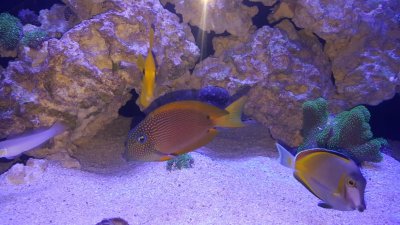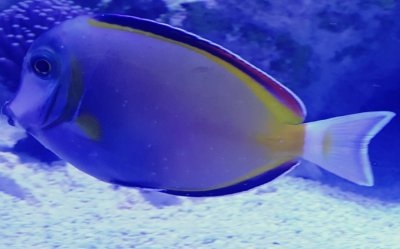- Joined
- Nov 15, 2019
- Messages
- 69
- Reaction score
- 257
Hello guys,
I hope you all have a good Christmas!
Two days ago after a 30% water change, I noticed white spots on my Powder Brown and Two Spot Bristletooth tang, which leads me to believe it's Ich.
In my DT I have about 18 fishes (14 small and 3 mid size tangs and 1x Foxface), few pieces of LPS corals and two anemones, and CUC. Since my corals are not attached to my large rocks, I was thinking on keeping the fish and remove the corals and inverts to a QT with proper lighting.
This way I spare the fish immunity from more stress, and myself from removing all my aquascape rocks while treating my entire DT tank for 6-8 weeks with Paraguard Seachem.
Then since Paraguard effects only last 24 hours after the last dose, I am planing on place my corals and inverts back to DT after the 6-8 weeks treatment period.
The white spots disappeared after 24 hours, and I assume they fell off to start the cycling to come back anytime soon. I want to deal with it ASAP and kill this plague before they come back and spread to my other fishes.
Would this be a safe route?
Anyone have successfully doing this?
Hypo-salinity, higher temperatures or any other suggestion for the treatment?
Thanks!


I hope you all have a good Christmas!
Two days ago after a 30% water change, I noticed white spots on my Powder Brown and Two Spot Bristletooth tang, which leads me to believe it's Ich.
In my DT I have about 18 fishes (14 small and 3 mid size tangs and 1x Foxface), few pieces of LPS corals and two anemones, and CUC. Since my corals are not attached to my large rocks, I was thinking on keeping the fish and remove the corals and inverts to a QT with proper lighting.
This way I spare the fish immunity from more stress, and myself from removing all my aquascape rocks while treating my entire DT tank for 6-8 weeks with Paraguard Seachem.
Then since Paraguard effects only last 24 hours after the last dose, I am planing on place my corals and inverts back to DT after the 6-8 weeks treatment period.
The white spots disappeared after 24 hours, and I assume they fell off to start the cycling to come back anytime soon. I want to deal with it ASAP and kill this plague before they come back and spread to my other fishes.
Would this be a safe route?
Anyone have successfully doing this?
Hypo-salinity, higher temperatures or any other suggestion for the treatment?
Thanks!




















